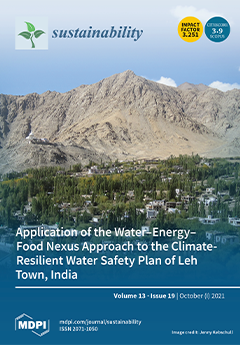This paper aims to analyze the associated environment and climate benefits of electrification by comparing the air pollutant and CO
2 emissions from the fuel cycle of battery electric commercial vehicles (BECVs) and internal combustion engine commercial vehicles (ICECVs) through a case study
[...] Read more.
This paper aims to analyze the associated environment and climate benefits of electrification by comparing the air pollutant and CO
2 emissions from the fuel cycle of battery electric commercial vehicles (BECVs) and internal combustion engine commercial vehicles (ICECVs) through a case study in Guangzhou Province. Five types of vehicles (i.e., electric buses, coaches, light-duty trucks, dump trucks, and waste haulers) used in the public service sector were selected for analysis, taking into account six development scenarios based on the prevalent ownership trends of electric vehicles and the energy system optimization process. The results reveal that an increase in commercial vehicle electrification in the public service sector will cause reductions of 19.3 × 10
3 tons, 0.5 × 10
3 tons, 9.5 × 10
3 tons, and 8.5 × 10
6 tons for NO
x, PM
2.5, VOCs, and CO
2, respectively, from the base 2030 case (CS_II, the electrification rates of buses, coaches, light-duty trucks, dump trucks, and waste haulers will reach 100%, 26.5%, 15.4%, 24.0%, and 33.1%, and their power needs will be met by 24% coal, 18.4% gas, and 13.2% renewable power), but with a slight increase in SO
2 emissions. With the further penetration of BECVs into the market, the emission reduction benefits for NO
x, PM
2.5, VOCs, and CO
2 could be even more remarkable. Moreover, the benefit obtained from the optimization of the share of renewable energy is more noticeable for CO
2 reduction than for air pollutant reduction. Prioritizing the electrification of light-duty trucks after completing bus electrification could be a potential solution for achieving ozone pollution control and lowering carbon emissions in Guangdong. In addition, these results can provide scientific support for the formulation or adjustment of advanced pollution mitigation and peaking carbon policies in Guangdong, as well as other regions of China.
Full article





